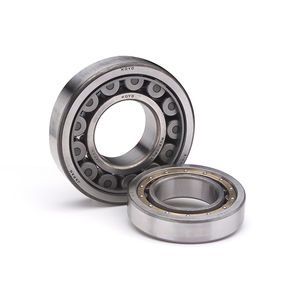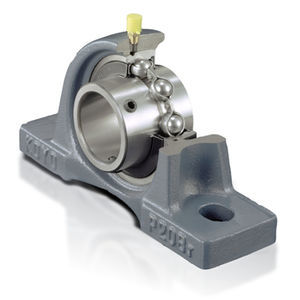
- Components - Spare Parts
- Landing and Braking
- Tapered roller bearing
- KOYO BEARINGS VIERZON MAROMME (GROUPE JTEKT)
Tapered roller bearing rollerradialaxial
Add to favorites
Compare this product
fo_shop_gate_exact_title
Characteristics
- Rolling element
- roller, tapered roller
- Configuration
- radial, axial, single-row, double-row, four-row
- Material
- steel
- Other characteristics
- with cage
- Applications
- for airliners
Description
This type of bearings is designed so that the cups, cones and rollers have tapered surfaces whose apexes converge at a common point on the bearing axis. This type is suitable for applications involving heavy or impact loading.
Taper roller bearings consist of an inner ring (cone), an outer ring (cup), a cage and rollers which are profiled to distribute the load evenly. They have high radial and axial (thrust) load capacities at low to intermediate speeds. Taper roller bearings are available in single-row, two-row and four-row designs. With single-row bearings, the thrust load capacity is about 60% of the radial capacity. Double-row bearings have a greater radial load capacity and can handle thrust loads in both directions. The rollers can be configured in such a way that the contact lines between the roller and the race converge or diverge towards the axis of rotation. Diverging double-row bearings increase the rigidity of the shaft mounting, while converging bearings do not. Other configurations for double-row bearings feature a single outer ring and two inner rings, or two outer rings and a single inner ring. Four-row tapered roller bearings consist of four rows of alternating converging and diverging rollers.
Most taper roller bearings are made of alloy steels or low-carbon steels. Some applications require the use of case-hardened or through-hardened, high-carbon, bearing-quality steel. High-carbon grades of steel do not require carburizing and can be case-hardened by induction heating or through-hardened by conventional heating methods.
Catalogs
No catalogs are available for this product.
See all of KOYO BEARINGS VIERZON MAROMME (GROUPE JTEKT)‘s catalogsOther KOYO BEARINGS VIERZON MAROMME (GROUPE JTEKT) products
PRODUCTS
Related Searches
- JTEKT bearing
- Ball bearing bearing
- JTEKT airliner bearing
- Steel bearing
- JTEKT roller bearing
- JTEKT radial bearing
- Precision bearing
- Double-row bearing
- Single-row bearing
- Angular-contact bearing
- Pre-lubricated bearing
- Heavy load bearing
- Deep groove bearing
- Cage assembly bearing
- Axial bearing
- Cylindrical roller bearing
- Self-aligning bearing
- Sealed bearing
- High-speed bearing
- Stainless steel bearing
*Prices are pre-tax. They exclude delivery charges and customs duties and do not include additional charges for installation or activation options. Prices are indicative only and may vary by country, with changes to the cost of raw materials and exchange rates.











